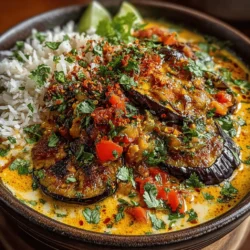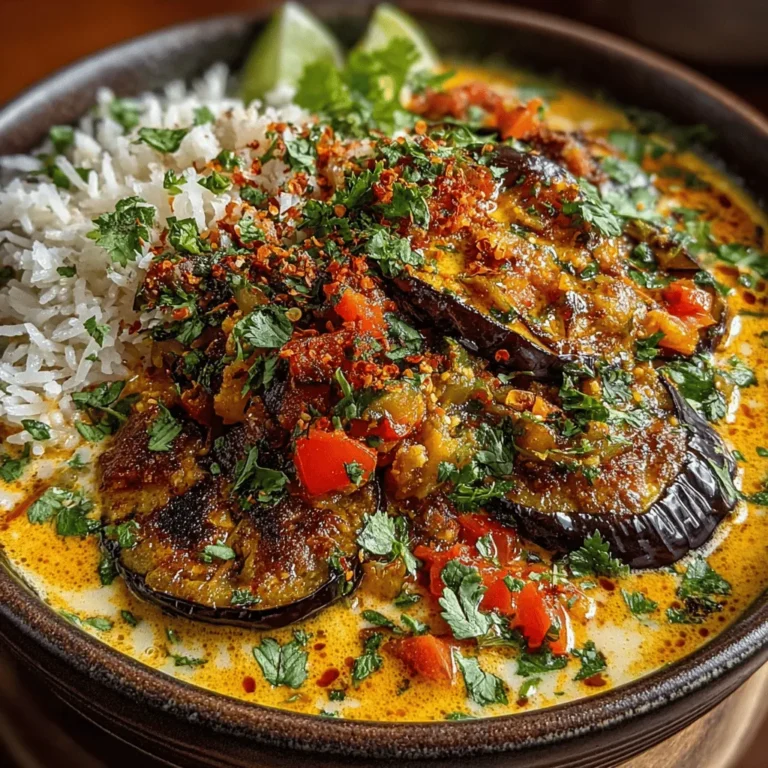Enjoy the Comfort of Crockpot Roasted Eggplant Curry: A Step-by-Step Guide
Introduction
Crockpot cooking is a cherished culinary technique that combines convenience with the ability to transform simple ingredients into rich, flavorful meals. The slow and steady heat of a crockpot allows flavors to meld beautifully, making it an ideal method for dishes like the Crockpot Roasted Eggplant Curry. This recipe captures the essence of comfort food, marrying the earthy flavors of eggplant with aromatic spices and creamy coconut milk. The result is a dish that is both satisfying and nourishing, perfect for family dinners or meal prep for the week ahead.
As we delve into this article, we will explore the benefits of using a crockpot, examine the key ingredients that bring this curry to life, and guide you through each step to create this delicious dish. Whether you are a seasoned cook or a beginner in the kitchen, this Crockpot Roasted Eggplant Curry is a fantastic addition to your recipe repertoire.
Understanding the Ingredients
To create a truly exceptional Crockpot Roasted Eggplant Curry, it’s essential to understand the key components that contribute to its delightful flavor and texture. Each ingredient plays a vital role in building the dish’s character, and knowing their benefits will help you appreciate the artistry behind this recipe.
The Role of Eggplant in the Dish
Eggplant, also known as aubergine, is the star ingredient in this curry. Its unique texture and flavor profile make it an excellent choice for absorbing spices and sauces. When cooked, eggplant becomes tender and creamy, offering a comforting bite that pairs beautifully with the other components of the curry.
Nutritionally, eggplant is low in calories and rich in fiber, vitamins, and minerals. It is a great source of antioxidants, particularly nasunin, which is known to have protective effects on brain health. Incorporating eggplant into your meals not only enhances flavor but also adds valuable nutrients to your diet.
Aromatics: Onion, Garlic, and Ginger
No curry is complete without its aromatics, and in this recipe, onion, garlic, and ginger take center stage. These foundational ingredients are essential for building flavor, creating a robust base that enriches the overall dish.
Onions provide sweetness and depth, while garlic adds a pungent kick, and ginger contributes a warm, zesty element. Together, they create a harmonious blend that elevates the curry. From a health perspective, these aromatics are known for their anti-inflammatory and immune-boosting properties, making them a beneficial addition to any meal.
The Power of Spices in Indian Cuisine
Spices are the heart and soul of Indian cooking, and this Crockpot Roasted Eggplant Curry features an aromatic blend that includes red curry paste, turmeric, cumin, coriander, and garam masala. Each spice contributes its own unique flavor and health benefits, transforming the dish into a culinary masterpiece.
– Red Curry Paste: This ingredient adds a rich depth of flavor and a hint of heat. It often contains red chili, garlic, and spices that enhance the overall taste profile.
– Turmeric: Known for its vibrant yellow color, turmeric is a powerhouse of antioxidants and has anti-inflammatory properties.
– Cumin and Coriander: These spices bring earthiness and warmth to the dish, complementing the other flavors beautifully.
– Garam Masala: A blend of various spices, garam masala adds complexity and a fragrant aroma, making it a crucial component of the curry.
The combination of these spices not only enhances flavor but also offers numerous health benefits, making this curry a wholesome choice.
Coconut Milk as a Creamy Base
Coconut milk is the key ingredient that gives the Curry its creamy consistency. This luscious liquid not only adds richness but also balances the spices, creating a velvety texture that envelops the eggplant and other vegetables.
For those following a vegan or dairy-free diet, coconut milk serves as a perfect substitute for traditional cream. It is also a source of healthy fats, particularly medium-chain triglycerides (MCTs), which can provide energy and promote heart health.
The Importance of Vegetable Broth
Vegetable broth is another essential component of this recipe, enhancing the flavor without adding unnecessary calories. It serves as the cooking liquid, allowing the eggplant and spices to meld together as they cook slowly in the crockpot.
Using vegetable broth not only deepens the overall flavor but also provides a base that is rich in nutrients. For those with dietary restrictions, there are plenty of alternatives available, including low-sodium broth or homemade versions that allow for customization according to personal preferences.
Preparing the Eggplant
Now that we understand the key ingredients, it’s time to prepare the eggplant, which is the cornerstone of the Crockpot Roasted Eggplant Curry. Proper preparation is crucial to ensure that the eggplant maintains its texture and flavor during the slow cooking process.
Mastering the First Step: Salting and Rinsing
One of the most important steps in preparing eggplant is salting. This technique is essential for drawing out bitterness and excess moisture, resulting in a more flavorful and appealing dish.
To salt the eggplant, begin by cutting it into bite-sized cubes. Place the cubes in a colander and sprinkle generous amounts of salt over them. Allow them to sit for about 30 minutes. During this time, the salt will draw out moisture, which can help prevent the eggplant from becoming soggy during cooking.
After the salting process, it’s important to rinse the eggplant thoroughly to remove excess salt. Rinsing also helps wash away any remaining bitterness. Once rinsed, pat the eggplant dry with a clean kitchen towel or paper towels to ensure it is as dry as possible before adding it to the crockpot. This step is crucial for achieving the perfect texture in the final dish, allowing the eggplant to roast beautifully and absorb all the flavors of the curry.
With the eggplant prepared, we can move on to the next steps in creating this delicious Crockpot Roasted Eggplant Curry, which will involve sautéing the aromatics to enhance their flavors before they mingle with the eggplant and other ingredients in the crockpot.
{{image_2}}
Creating a Flavor Foundation
The foundation of any great curry lies in the careful preparation of its base ingredients. In this section, we will focus on the essential techniques for sautéing onions, garlic, and ginger, which are crucial for building a rich flavor profile.
Techniques for Sautéing Onions, Garlic, and Ginger
1. Choosing the Right Pan: Use a heavy-bottomed skillet or pan for even heat distribution. Non-stick or cast iron pans work well.
2. Chopping Ingredients: Dice onions finely to ensure they cook evenly and caramelize beautifully. Mince garlic and ginger to release their essential oils and flavors.
3. Heat Control: Start by heating your pan over medium heat. This allows the onions to soften without burning. Once the pan is hot, add a splash of oil.
4. Sautéing: Add the diced onions first, stirring frequently. Allow them to cook until they turn translucent and slightly golden (about 5-7 minutes). Next, add the minced garlic and ginger. Sauté for an additional 1-2 minutes until fragrant, being careful not to let them brown too much, as burnt garlic can impart a bitter taste.
The Importance of Cooking Aromatics Thoroughly
Cooking aromatics like onion, garlic, and ginger thoroughly is crucial for releasing their natural sugars and flavors. This process enhances the overall taste of the curry. Undercooked aromatics can lead to a raw, harsh flavor, which detracts from the dish. Aim for a balance where the onions are sweet, and the garlic and ginger are fragrant but not burnt.
Timing and Temperature Tips for Optimal Flavor Release
To maximize flavor release, maintain a steady medium heat throughout the sautéing process. If the ingredients begin to stick or brown too quickly, reduce the heat slightly. This allows for even cooking and prevents scorching, ensuring the sweet notes of the onions and the zest of the garlic and ginger shine through.
Mixing the Spices
Building Complexity in Flavor
The next step in creating your Crockpot Roasted Eggplant Curry is to incorporate a blend of spices that will enhance the dish’s complexity.
How to Properly Incorporate Spices into the Sautéed Mixture
1. Timing: Add spices such as cumin, coriander, turmeric, and garam masala to the sautéed onions, garlic, and ginger mixture. This should be done after the aromatics have softened, allowing the spices to bloom.
2. Stirring: Mix the spices into the sautéed mixture thoroughly. This ensures that each ingredient is well-coated, allowing the spices to release their essential oils and flavor.
The Significance of Cooking Spices Briefly to Enhance Aromas
Cooking spices briefly—usually for about 30 seconds to a minute—releases their aromas and intensifies their flavors. This process, known as “blooming,” allows the spices to meld with the aromatics, creating a fragrant base that will permeate the entire dish. Keep an eye on the mixture to prevent burning; if you notice any browning, lower the heat.
Combining Ingredients in the Crockpot
The Heart of the Recipe
Now that your aromatic base is ready, it’s time to transfer everything to the crockpot and layer in the remaining ingredients.
Step-by-Step Guide on Layering Ingredients in the Crockpot
1. Transfer the Aromatics: Start by adding the sautéed onion, garlic, and ginger mixture to the crockpot. Scrape the bottom of the pan to include any flavorful bits that may have stuck.
2. Add the Eggplant: Next, layer in the diced roasted eggplant. Make sure the eggplant is evenly distributed across the base of the crockpot.
3. Incorporate Vegetables: Add your choice of vegetables (such as diced tomatoes, bell peppers, and spinach) on top of the eggplant. These will add texture and color to your curry.
4. Pour in Liquid: Depending on your preference, add vegetable broth or coconut milk to the crockpot. This will create a rich, creamy sauce that binds the flavors.
5. Season and Stir: Before you close the lid, season with salt, pepper, and any additional spices you desire. Stir everything gently to ensure an even distribution of flavors.
Importance of Stirring for Even Flavor Distribution
Stirring the ingredients in the crockpot is crucial for ensuring the spices, vegetables, and eggplant intermingle. This step helps to create a harmonious flavor throughout the dish, allowing each bite to be equally delicious. A gentle stir also helps to incorporate the liquid, which will keep the ingredients moist during cooking.
Cooking the Curry
Setting it and Forgetting it: The Magic of the Crockpot
One of the greatest advantages of using a crockpot is the ability to set it and forget it.
Understanding Cooking Times: Low vs. High Settings
– Low Setting: For a more tender result, cook your curry on the low setting for approximately 6-8 hours. This allows the flavors to meld beautifully and the eggplant to become perfectly soft.
– High Setting: If you’re short on time, the high setting takes about 3-4 hours. While the dish will still be flavorful, the eggplant may not be as tender and creamy as when cooked on low.
What to Expect During Cooking: Signs of Readiness
As your curry cooks, you’ll notice the delightful aroma wafting through your kitchen. This is a sign that the spices and ingredients are melding beautifully. When the cooking time is nearing completion, check for the following signs to determine readiness:
– The eggplant should be soft and tender.
– The sauce should have thickened slightly.
– Flavors should be well-developed, with a rich, aromatic scent.
Adjusting Seasoning
Elevating the Dish to Perfection
Once your Crockpot Roasted Eggplant Curry is done cooking, it’s time to taste and adjust the seasoning to your liking.
Techniques for Tasting and Adjusting Flavor Profiles
1. Tasting: Using a clean spoon, taste a small amount of the curry. This will help you assess the balance of flavors, including the saltiness and spice level.
2. Adjusting: If the dish needs more flavor, consider adding a pinch of salt or a dash of acidity—such as lemon juice or vinegar—to brighten the flavors. If you prefer a spicier curry, incorporate additional cayenne pepper or chili powder.
The Role of Salt and Pepper in Balancing the Dish
Salt is essential for enhancing flavors, while pepper adds a subtle kick. When adjusting seasoning, be cautious and add small amounts incrementally. Remember that you can always add more, but it’s challenging to fix an overly salted dish.
Serving Suggestions
Presenting Your Dish Beautifully
Now that your curry is perfectly seasoned, it’s time to serve it up!
Tips for Garnishing with Fresh Cilantro
Fresh herbs like cilantro add a burst of color and flavor to your presentation. Chop a handful of cilantro and sprinkle it over the curry just before serving. This not only enhances the visual appeal but also adds freshness that complements the richness of the curry.
Ideas for Pairing: Rice vs. Naan and the Benefits of Each
– Rice: Serve your curry over a bed of fluffy basmati or jasmine rice. The rice soaks up the flavorful sauce, making each bite deliciously comforting.
– Naan: Alternatively, serve with warm naan bread, perfect for scooping up the curry. Naan provides a delightful texture and a slightly chewy contrast to the creamy curry.
Presentation Techniques for a Stunning Table Setting
To elevate your dining experience, consider the following presentation tips:
– Use Colorful Bowls: Serve the curry in vibrant bowls to make it visually appealing.
– Add Texture: Include side dishes, such as a simple cucumber salad or pickled vegetables, for added color and crunch.
– Lighting: Set the table with warm lighting and perhaps some candles for a cozy ambiance.
Conclusion
Crockpot Roasted Eggplant Curry is not just a meal; it’s an experience that brings warmth and comfort to the dining table. By following the detailed steps outlined in this article, you’ll be able to create a delicious dish that impresses family and friends alike. The careful selection and preparation of ingredients, combined with the ease of crockpot cooking, make this recipe a go-to for busy weeknights or leisurely weekend meals. Enjoy the rich flavors and the satisfaction of a homemade curry that is as nourishing as it is delicious.


